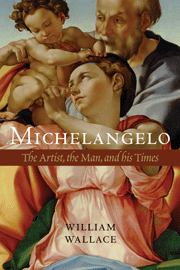Angela Nickerson of travel blog The Gypsy’s Guide, and author of A Journey into Michelangelo’s Rome posted a fine interview with Michelangelo author William Wallace.
 Eight Questions for William Wallace
Eight Questions for William Wallace When I was researching and writing A Journey into Michelangelo’s Rome, I read thousands and thousands of pages — books, articles, interviews, journals — and one name kept popping up in my research, that of Dr. William Wallace.
Dr. Wallace, a professor at Washington University in St. Louis, is one of the world’s foremost experts on Michelangelo — a specialty which takes him to Italy frequently. He has just published a new biography, Michelangelo: the Artist, the Man, and his Times. It is delightfully readable and creates a fuller, more intimate portrait of the Renaissance genius.
AKN: You have devoted most of your academic research to the study of Michelangelo. How did you come to choose him as your subject?
William Wallace: I first traveled to Italy as a junior in college. I was an art history major, but on that three-week trip I realized “this is it!” I had read The Agony and the Ecstasy. I thought it was a pretty good read. But on that first trip I had that experience that so many people have when traveling in Italy. No matter how often great works of art are reproduced, that moment when you walk into the Sistine Chapel for the first time is so dramatically different. My breath was taken away.
AKN: Italy draws millions of visitors each year in large part because of the artistic treasures there. What is it about the Italian Renaissance, in particular, that resonates with travelers and art-lovers around the world?
William Wallace: First of all, Italy has a wonderful climate, good food, and engaging people. That’s part of the draw. But the Renaissance, in scholarly terms, is “early modern.” The institutions and way of life are recognizably modern. Their banking, their politics, their basic ways of life aren’t so foreign that most Westerners recognize them without much work. And Renaissance Italy was a region of vast wealth, and there was a coincidence of tremendous talent and tremendous wealth which transformed cities like Florence into what we see now — an outdoor museum.
When we travel we go away to see the familiar — the David, for example. We’ve all seen images of it, so we go to Florence to see it in person. But while we are there, we also experience the unfamiliar. So many people visit the Academy, where Michelangelo’s David is, and when they return they say, “I went expecting to love the David, and I did. But I was even more impressed by Michelangelo’s slaves.” The familiar introduces us to the unfamiliar in a way that is both challenging and comforting.
Keep reading at The Gypsy’s Guide >>
Latest Comments
Have your say!